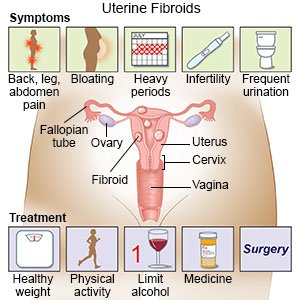Uterine Fibroids
Medically reviewed by Drugs.com. Last updated on Aug 4, 2025.
AMBULATORY CARE:
Uterine fibroids
are growths found inside your uterus. Uterine fibroids are benign (not cancer) and may also be called myomas or leiomyomas. Uterine fibroids often appear in groups, or you may have only one. They can be small or large, and they can grow. Fibroids likely will not spread to other parts of your body. They may grow when you are pregnant and shrink after you no longer have a monthly period.
 |
Signs and symptoms of uterine fibroids:
You may have no signs or symptoms. Symptoms depend on the size, type, and number of fibroids you have. Symptoms also depend on where the fibroids are inside your uterus:
- Heavy or painful menstrual bleeding
- Pelvic pressure and pain
- Increased pelvic pain during sex
- Constipation or pain when you have a bowel movement
- Need to urinate often
Seek care immediately if:
- Your heart begins to race, and you feel faint.
- You begin to pass large blood clots from your vagina.
Call your doctor or gynecologist if:
- Your symptoms do not go away, or they get worse.
- You feel weak and are more tired than usual.
- You do not feel like your bladder is empty after you urinate. You also may urinate small amounts more often.
- You have questions or concerns about your condition or care.
Treatment:
Watchful waiting may be recommended if your signs and symptoms are mild. The following treatments may shrink your fibroids and decrease your symptoms:
- Medicines:
- Medicines that decrease hormones may help shrink your fibroids and decrease menstrual bleeding.
- Oral contraceptives can help control menstrual bleeding.
- NSAIDs help decrease swelling and pain or fever. This medicine is available with or without a doctor's order. NSAIDs can cause stomach bleeding or kidney problems in certain people. If you take blood thinner medicine, always ask your healthcare provider if NSAIDs are safe for you. Always read the medicine label and follow directions.
- Uterine artery embolization (UAE) may help decrease the size of the fibroid. Embolization blocks blood flow to the fibroid. This causes it to shrink and put less pressure on your organs and tissues.
- Radiofrequency ablation (RFA) decreases the blood flow to the fibroids and helps destroy them. RFA is a laparoscopic procedure that uses radiofrequency energy to treat the fibroids.
- Endometrial ablation is a procedure that destroys the lining of your uterus (endometrium). Heat, cold, or different types of energy may be used. This procedure may help decrease heavy menstrual bleeding.
- Surgery may be used to remove your fibroids and leave your uterus in place. Surgery may instead be used to remove your fibroids and uterus.
Treatment options
The following list of medications are related to or used in the treatment of this condition.
Prevent uterine fibroids:
- Maintain a healthy weight. Extra weight can increase your risk for fibroids. Talk to your healthcare provider about a healthy weight for you. Your provider can help you create a healthy weight loss plan, if needed.
- Eat a variety of healthy foods. Fruits and vegetables are especially important to help lower the risk for fibroid. Other healthy foods include whole-grain breads, low-fat dairy products, beans, lean meats, and fish. Your healthcare provider or a dietitian can help you create a healthy meal plan.

- Limit or do not drink alcohol, as directed. Alcohol can increase your risk for fibroids. A drink of alcohol is 12 ounces of beer, 1½ ounces of liquor, or 5 ounces of wine. Ask your healthcare provider for information if you need help to quit drinking alcohol.
Follow up with your doctor or gynecologist as directed:
Write down your questions so you remember to ask them during your visits.
© Copyright Merative 2025 Information is for End User's use only and may not be sold, redistributed or otherwise used for commercial purposes.
The above information is an educational aid only. It is not intended as medical advice for individual conditions or treatments. Talk to your doctor, nurse or pharmacist before following any medical regimen to see if it is safe and effective for you.
Learn more about Uterine Fibroids
Treatment options
Care guides
Further information
Always consult your healthcare provider to ensure the information displayed on this page applies to your personal circumstances.
